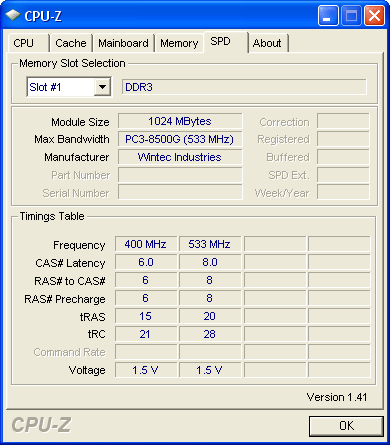DDR3-1333 Speed and Latency Shootout
Wintec AMPX PC3-10600
Familiar mostly to a small group of OEM system manufacturers, Wintec Industries has produced a performance line under the AMPX brand for several product cycles and hopes its performance brand will continue to gain traction with value-minded enthusiasts. The company sent a pair of its latest AMPX PC3-10600 1 GB modules for this competition.
Rated at basic 9-9-9-24 timings using a system's default 1.50 volts, this part number 3AHX1333C9-2048K 2 x1 GB dual-channel kit is designed to support whatever overclock enthusiastic users can extract, but doesn't include any "official" overclock validation like those of so many higher-priced brands.
In fact, Wintec AMPX PC3-10600 doesn't include SPD values for anything greater than DDR3-1066 and the modules are electronically labeled as the lower-speed parts. Builders must instead manually configure both speed and timings even though the modules are rated to operate at DDR3-1333 using stock voltage.
One would think that if the rated speed used stock voltage it would have been included in the SPD table. Perhaps the setting will be added to later production parts.
Current page: Wintec AMPX PC3-10600
Prev Page Super Talent PC3-10600 CL8 Next Page SPD Timing ComparisonGet Tom's Hardware's best news and in-depth reviews, straight to your inbox.
-
dv8silencer I have a question: on your page 3 where you discuss the memory myth you do some calculations:Reply
"Because cycle time is the inverse of clock speed (1/2 of DDR data rates), the DDR-333 reference clock cycled every six nanoseconds, DDR2-667 every three nanoseconds and DDR3-1333 every 1.5 nanoseconds. Latency is measured in clock cycles, and two 6ns cycles occur in the same time as four 3ns cycles or eight 1.5ns cycles. If you still have your doubts, do the math!"
Based off of the cycle-based latencies of the DDR-333 (CAS 2), DDR2-667 (CAS 4), and DDR3-1333 (CAS8), and their frequences, you come to the conclusion that each of the memory types will retrieve memory in the same amount of time. The higher CAS's are offset by the frequences of the higher technologies so that even though the DDR2 and DDR3 take more cycles, they also go through more cycles per unit time than DDR. How is it then, that DDR2 and DDR3 technologies are "better" and provide more bandwidth if they provide data in the same amount of time? I do not know much about the technical details of how RAM works, and I have always had this question in mind.
Thanks -
Latency = How fast you can get to the "goodies"Reply
Bandwidth = Rate at which you can get the "goodies" -
So, I have OCZ memory I can run stable atReply
7-7-6-24-2t at 1333Mhz or
9-9-9-24-2t at 1600Mhz
This is FSB at 1600Mhz unlinked. Is there a method to calculate the best setting without running hours of benchmarks? -
Sorry dude but you are underestimating the ReapearX modules,Reply
however hard I want to see what temperatures were other modules at
a voltage of ~ 2.1v, does not mean that the platinum series is not performant but I saw a ReapearX which tended easy to 1.9v(EVP)940Mhz, that means nearly a DDR 1900, which is something, but in chapter of stability/temperature in hours of functioning, ReapearX beats them all. -
All SDRAM (including DDR variants) works more or less the same, they are divided in banks, banks are divided in rows, and rows contain the data (as columns).Reply
First you issue a command to open a row (this is your latency), then in a row you can access any data you want at the rate of 1 datum per cycle with latency depending on pipelining.
So for instance if you want to read 1 datum at address 0 it will take your CAS lat + 1 cycle.
So for instance if you want to read 8 datums at address 0 it will take your CAS lat + 8 cycle.
Since CPUs like to fill their cache lines with the next data that will probably be accessed they always read more than what you wanted anyway, so the extra throughput provided by higher clock speed helps.
But if the CPU stalls waiting for RAM it is the latency that matters.


